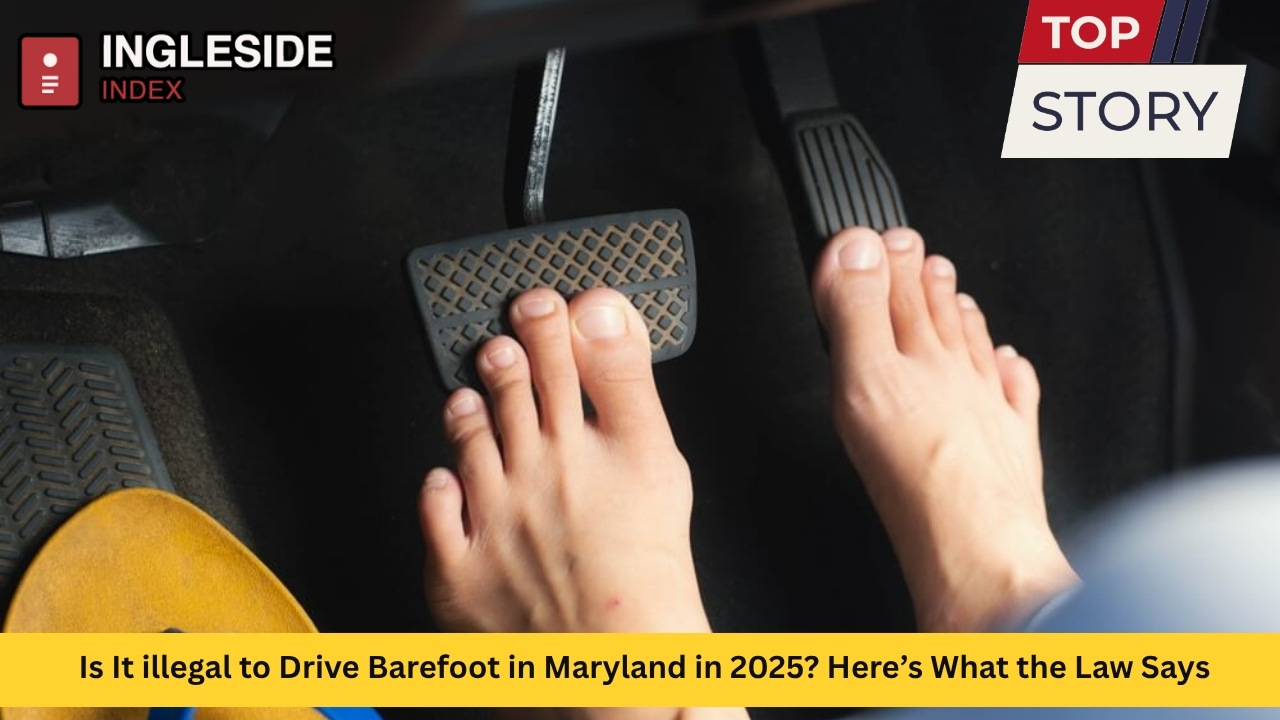Everyone has heard the rumor: driving barefoot is illegal. It’s the kind of myth that goes around at cookouts in Annapolis, gets repeated in classrooms in Rockville, or comes up when discussing a traffic stop in Baltimore. As we move through 2025, Maryland drivers are right to wonder what’s fact and what’s fiction. Is there any truth to the fear that kicking off your shoes behind the wheel could land you in legal trouble? This comprehensive guide dives deep into the laws, practical realities, and local culture around barefoot driving across Maryland’s cities and roads.
Understanding the Law: Barefoot Driving in Maryland
As of 2025, there is no law in Maryland that makes it illegal to drive without shoes on. This holds true whether you’re driving through the historic streets of Frederick, the coastal routes around Ocean City, or navigating Interstate 95 from Laurel to Silver Spring. The Maryland Vehicle Law does not specifically prohibit or even address the issue of barefoot driving, and you won’t find a statute on the books that says covering your feet is required to operate a passenger vehicle.
While Maryland state law does not restrict barefoot driving, some local municipalities can, in theory, pass ordinances that relate to road safety. However, even in Maryland’s largest cities—like Baltimore, Columbia, and Germantown—there are no known local ordinances prohibiting barefoot driving for passenger cars.
Motorcyclists should note that a handful of states require footwear for two-wheeled vehicles, but Maryland does not. However, most motorcyclists choose to ride with sturdy footwear for their own safety.
Why the Myth Persists
Historical Roots of the Myth
The pervasive belief that driving barefoot is illegal likely started decades ago. Some speculate this originated from public safety campaigns. Others point to certain old DMV driver education books that cautioned against barefoot driving without ever saying it was illegal.
Law Enforcement and Common Practices
While police in Baltimore or Montgomery County will not ticket you specifically for driving barefoot, some officers may advise against it as a matter of safety. This is a recommendation, not an enforceable law. Police advice is often confused with statutory requirement, adding to the confusion.
Safety Considerations: Is Barefoot Driving Dangerous?
Barefoot Driving vs. Unsafe Footwear
While it is legal to drive barefoot, that doesn’t automatically mean it is the safest choice. In some conditions, driving barefoot can reduce your ability to apply the necessary pressure to pedals. For instance, sudden braking in traffic-heavy corridors like US-50 in Prince George’s County could be impaired without proper traction from the footwear.
However, it’s also worth noting that certain shoes—such as sandals, flip-flops, or high heels—can be much more dangerous. Loose shoes can slip or wedge under pedals, leading to accidents. In fact, some road safety experts argue that bare feet may offer more control than unsuitable footwear.
Accident Data and Studies
-
National traffic safety statistics illustrate that improper footwear contributes to hundreds of pedestrian and driver accidents each year.
-
A study found that flip-flops and high heels are responsible for a notable portion of pedal misapplication incidents in urban settings—cities like Baltimore and Bethesda included.
-
In Maryland, the majority of serious accidents involving pedal misapplication stem from distraction or impaired driving, not from bare feet.
The Insurance Angle
In the event of an accident, insurance companies in Maryland may consider barefoot driving a possible factor if the lack of footwear impaired your ability to safely control your vehicle. While being shoeless does not automatically make you at fault, it could potentially be cited as “contributory negligence” if your bare feet played a role in causing the crash.
What Maryland Law Actually Says About Safe Driving
Negligence, Reckless Driving, and Civil Liability
Maryland law places heavy emphasis on the concept of “negligent” or “reckless” driving. If an accident occurs and it is shown that your barefoot driving contributed to the incident, you might be cited for negligence. Maryland is a “contributory negligence” state, which means that if you are found to be even minimally at fault in a car accident (as little as 1%), you might be barred from claiming damages.
Imagine this scenario: You brake suddenly in downtown Baltimore and your bare foot slips, causing you to rear-end another vehicle. If it can be proven that your choice of not wearing shoes contributed to the crash, it could impact the outcome of insurance claims and lawsuits—even if it wasn’t the sole cause.
Law Enforcement Discretion
While there is no statute mandating footwear, law enforcement officers retain considerable discretion. If an officer believes your barefoot driving contributed to reckless or unsafe operation of your vehicle, you might be cited for reckless driving, not for being barefoot per se but for failing to maintain proper control.
Barefoot Driving in Maryland’s Major Cities
Baltimore
Baltimore, Maryland’s largest city, represents a melting pot of urban driving challenges—congested intersections, uneven road surfaces, and frequent stop-and-go traffic. Drivers in Baltimore should be especially mindful of the practical challenges of driving barefoot in unpredictable conditions.
Rockville and Montgomery County
Rockville, in one of Maryland’s busiest counties, is no stranger to heavy commuter traffic, especially along I-270. Drivers here sometimes report seeing others driving barefoot, especially in the summer months. The city’s police confirm there’s no focus on ticketing barefoot drivers, but safety is always encouraged.
Ocean City
Ocean City, with its sandy beaches and laid-back vibe, often tempts motorists to leave shoes in the car after a day on the shore. Local police advise that while it’s not illegal, wet or sandy feet can cause pedals to become slippery, elevating risk during tourism surges in the summer.
Annapolis
As the state’s capital and home to the U.S. Naval Academy, Annapolis presents a mix of old cobblestone alleys and modern avenues. Many Annapolis drivers feel more comfortable—and safer—driving with at least closed-toe shoes due to frequent stops and sometimes slick roadways from Chesapeake Bay weather.
Common Questions About Barefoot Driving
Can I be ticketed just for driving barefoot in Maryland?
No, there is no state law prohibiting it. Officers may suggest safer alternatives but cannot issue a citation for bare feet alone.
Will driving barefoot affect my insurance claim?
If your lack of footwear is determined to be a contributing factor in an accident, it could affect your claim. This depends on the particulars of each case and the findings of any accident investigation.
Are there any cities in Maryland with their own restrictions?
As of 2025, no city—including Baltimore, Annapolis, Rockville, Ocean City, or Silver Spring—has an ordinance making barefoot driving illegal for passenger vehicles.
What about driving commercial vehicles?
Companies often set their own policies regarding driver attire, including footwear. Professional drivers should always follow employer guidelines, regardless of state law.
The Real Risks of Driving Barefoot
Physical Risks
Bare feet offer minimal protection from debris on car floors, sharp pedal edges, or hot surfaces—especially problematic during Maryland’s summer months. A sudden cut or burn can cause enough pain to create a hazardous driving distraction.
Legal Implications
Although the act itself isn’t illegal, if you’re involved in an accident, your choice to drive barefoot may come under scrutiny, particularly in civil lawsuits. Maryland’s rigid contributory negligence law means even a minor misstep can cost you recovery in damages.
Barefoot Driving Around the US: A Snapshot
A fascinating but little-known survey revealed that approximately 25% of drivers in the U.S. admitted to having driven barefoot at some point. In beach states—like Maryland during the tourist season—those rates can be even higher. Each state addresses risks differently, but none (including California, Florida, or Maryland) specifically bans the practice.
Maryland’s Road Safety in 2025: Key Facts
-
As of mid-2025, Maryland’s Department of Transportation reported over 110,000 traffic accidents for the year.
-
Human error is still the leading cause, accounting for about 94% of accidents statewide.
-
Pedal misapplication—a risk with both improper footwear and bare feet—has contributed to several dozen serious collisions annually in urban centers like Baltimore, Rockville, and Towson.
-
The state continues to run public safety campaigns encouraging proper footwear and driver readiness.
Real Stories from Maryland Drivers
Megan in Columbia
After kicking off her sandals near Lake Kittamaqundi, Megan found driving barefoot gave her better pedal control while parking. She chooses to do this only in parking lots or short drives and always keeps flats handy.
Carlos from Bethesda
Carlos prefers sneakers after a near-miss in heavy traffic. “I tried barefoot once. My foot slipped off the brake in Chevy Chase, and I realized it just wasn’t worth the risk.”
Tanya in Ocean City
For beach-goers like Tanya, convenience sometimes outweighs caution. “It feels freeing,” she says, “but after a friend had an accident because her wet feet slipped off the clutch, I always towel off and put shoes back on before leaving the boardwalk.”
What to Do If You’re Involved in an Accident While Barefoot
-
Stay calm and attend to any injuries immediately.
-
Inform responding officers of the circumstances. Honesty is crucial; explain your footwear choice and any relevant context.
-
Document everything: Take photos of your pedals, your feet, and any loose shoes.
-
Contact your insurance promptly. Be prepared for questions about your footwear, but remember that barefoot driving is not inherently illegal.
-
Seek legal advice if needed: Especially if the role of your barefoot driving is questioned in any potential claims or suits.
Myths and Misconceptions About Barefoot Driving
-
“You’ll automatically get a ticket if a cop sees you barefoot.” False. No law mandates footwear for drivers.
-
“Insurance won’t cover you if you drive barefoot.” Not necessarily; coverage depends on whether driving barefoot contributed to an accident.
-
“Barefoot driving is less safe than all shoes.” Not true for every case—some shoes are more hazardous than going barefoot.
Final Thoughts
The enduring myth that it’s illegal to drive barefoot in Maryland has deep roots, but it’s simply not true. No matter which city you call home — Frederick, Columbia, Bowie, or Baltimore — the law is clear. While you’re free to drive unshod, consider the practical implications for your safety and liability. The roads of Maryland are safest when drivers are alert, in control, and prepared for whatever comes next—even if it simply means wearing the right pair of shoes.
Helpful Links
- https://wgk-law.com/blog/is-it-legal-to-drive-barefoot-in-maryland/
- https://www.mdot.maryland.gov/tso/pages/newsroomdetails.aspx?newsId=938&PageId=38
- https://www.marksandharrison.com/blog/is-it-illegal-to-drive-barefoot/
- https://mgaleg.maryland.gov/2025RS/bills/sb/sb0590t.pdf




